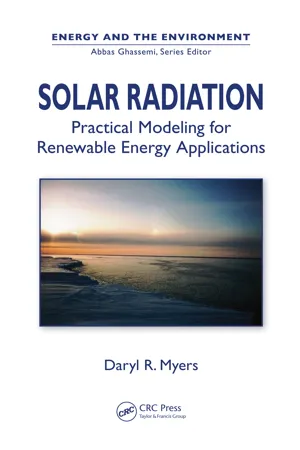
- 210 pages
- English
- ePUB (mobile friendly)
- Available on iOS & Android
About This Book
Written by a leading scientist with over 35 years of experience working at the National Renewable Energy Laboratory (NREL), Solar Radiation: Practical Modeling for Renewable Energy Applications brings together the most widely used, easily implemented concepts and models for estimating broadband and spectral solar radiation data. The author addresses various technical and practical questions about the accuracy of solar radiation measurements and modeling.
While the focus is on engineering models and results, the book does review the fundamentals of solar radiation modeling and solar radiation measurements. It also examines the accuracy of solar radiation modeling and measurements. The majority of the book describes the most popular simple models for estimating broadband and spectral solar resources available to flat plate, concentrating, photovoltaic, solar thermal, and daylighting engineering designs. Sufficient detail is provided for readers to implement the models in assorted development environments.
Covering the nuts and bolts of practical solar radiation modeling applications, this book helps readers translate solar radiation data into viable, real-world renewable energy applications. It answers many how-to questions relating to solar energy conversion systems, solar daylighting, energy efficiency of buildings, and other solar radiation applications.
Frequently asked questions
Information
1 | Fundamentals of Solar Radiation |

Table of contents
- Cover
- Half Title
- Title Page
- Copyright Page
- Dedication
- Table of Contents
- Series Editor
- Series Editor’s Preface
- Preface
- Acknowledgments
- About the Author
- Chapter 1 Fundamentals of Solar Radiation
- Chapter 2 Introduction to Solar Radiation Measurements
- Chapter 3 Modeling Clear Sky Solar Radiation
- Chapter 4 Modeling Global Irradiance under All Sky Conditions
- Chapter 5 Modeling Missing Components
- Chapter 6 Applications: Modeling Solar Radiation Available to Collectors
- Chapter 7 Introduction to Modeling Spectral Distributions
- Chapter 8 Introduction to Modeling Daylight
- Chapter 9 Summary and Future Prospects
- Appendix A: Bird Clear Sky Model in Excel
- Appendix B: Excel Structure for DISC Model of Direct Normal Irradiance (DNI) from Global Horizontal Irradiance (GHI)
- Appendix C: Tables for CIE D65 Reference Spectrum and Spectral Daylight Temperature Model
- Appendix D: SPCTRL2 FORTRAN Source Code
- Appendix E: Photopic Response Function V(λ) Curve
- Appendix F: Perez Anisotropic Model Coefficients for Luminous Efficacy and Zenith Luminance Model
- Index